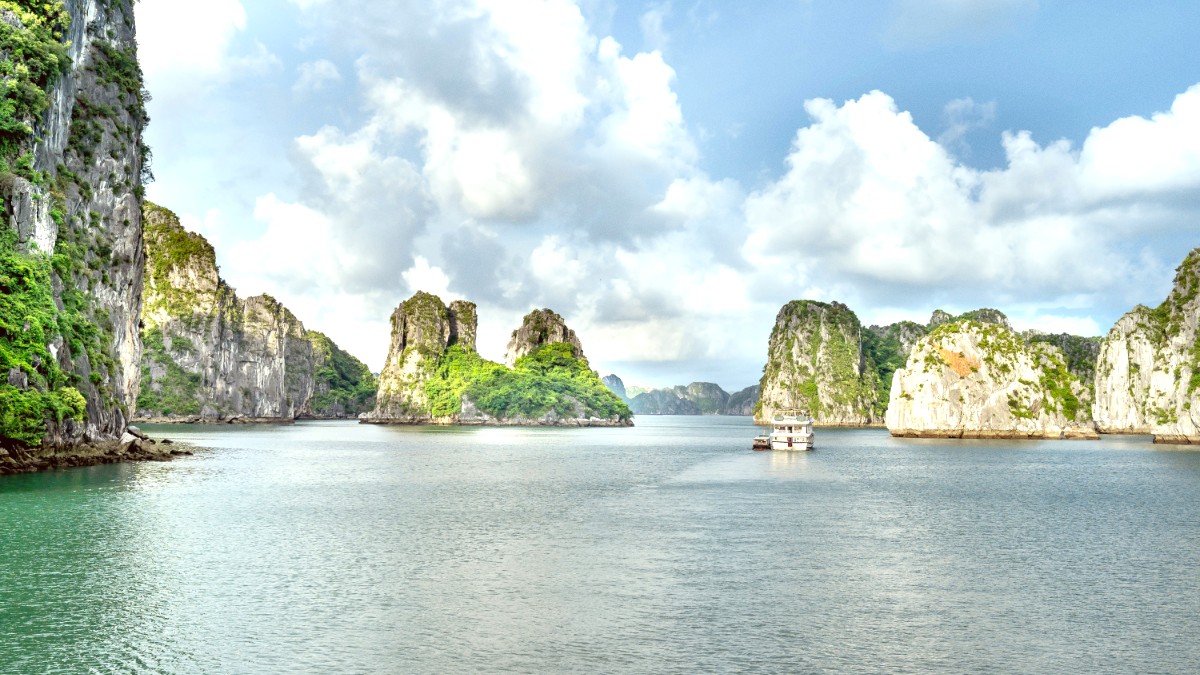
Northeast Vietnam, Vietnam
Spring (March - April) has pleasant weather, with temperatures typically ranging from 20-25°C (68-77°F) and relatively low humidity. Light rainfall occurs, and clear skies appear often. Summer (May - August) temperatures often reach 28-32°C (82-90°F), with high humidity and substantial rainfall. Tropical storms are a risk during these months. Autumn (September - October) is a prime time, with warm, pleasant temperatures (25-28°C / 77-82°F) and clear skies. Winter (November - February) brings cooler temperatures (15-20°C / 59-68°F) and dry weather, though January and February often feature persistent fog or mist.
Typhoons and tropical storms occur mainly from July to October, bringing heavy rainfall and strong winds. This weather can lead to cruise cancellations for safety reasons. Monitor weather forecasts closely for these months. Winter fog can persist for days, creating a dramatic, mysterious appearance, but it can obscure views of the karsts.
The bay experiences a tropical monsoon climate. The rainy season typically runs from May to October, with July and August being the wettest months. Tropical storms and typhoons are a risk from July to October. Cruise operators prioritize safety, canceling or delaying trips when storms approach.
Winter fog can persist for days, especially in January and February. This dense mist creates a dramatic, mysterious appearance, but it can significantly reduce visibility for distant views of the karsts. Be prepared for this possibility if visiting during winter.
Sept-Nov, Mar-Apr
Optimal weather, clear skies, excellent visibility for all activities.
Higher prices for cruises/accommodation, more crowded attractions.
Winter (Dec-Feb)
Fewer crowds, quieter experience, lower prices, unique misty atmosphere.
Can be chilly, limited visibility due to fog possible.
Summer (May-Aug)
Lush green landscapes, warm water for swimming, fewer tourists, good deals.
High heat and humidity, significant typhoon/heavy rain risk, cruise cancellations possible.
September-November and March-April offer the best weather for clear views and comfortable conditions. Mild temperatures and reduced rainfall are ideal for long hours on the water.
May-October brings warmer water temperatures for swimming. Always swim in designated, safe areas.
Winter (Jan-Feb) creates unique misty opportunities for ethereal shots.
Late summer brings a higher typhoon risk.
Swim only in designated, safe areas within the bay.
Consider travel insurance that covers trip cancellation due to weather events. Explore World Nomads or SafetyWing.
Book well in advance for high season visits.
Vietnam has specific visa and entry requirements that vary by nationality and stay duration. Plan your visa application in advance to avoid complications. Always check the latest regulations.
Many nationalities enjoy visa exemptions for certain durations. Citizens from Germany, France, Italy, Spain, UK, Russia, Japan, South Korea, Denmark, Finland, Norway, Sweden, and Belarus can enter without a visa for up to 45 days. Other ASEAN countries receive exemptions for 30 days or less. Confirm your country’s status and permitted duration.
The Visa on Arrival (VOA) option requires an approval letter obtained from a licensed Vietnamese travel agency online before your arrival. This option is not available for land or sea border crossings. Alternatively, a traditional visa can be obtained from a Vietnamese embassy or consulate in your home country.
Halong Bay offers options for every budget, from very economical travel to luxurious experiences. The official currency is the Vietnamese Dong (VND).
While Vietnam is generally a safe destination for tourists, awareness and preparation help avoid common issues.
Consult a travel health professional 4-6 weeks prior for personalized advice (Hepatitis A & B, Typhoid, Japanese Encephalitis, Rabies).
Drink only bottled/purified water. Avoid ice. Eat hot, freshly cooked food. Wash hands often. Carry Anti-diarrhea medication.
Use Insect repellent (DEET/picaridin). Wear long sleeves/pants in evenings. Malaria risk is generally low in Halong Bay.
Protect yourself from the strong sun: Use broad-spectrum sunscreen, wear a wide-brimmed hat and sunglasses, stay hydrated, and avoid peak sun hours.
Food hygiene standards vary. Choose reputable eateries and busy street food stalls with high turnover. Ensure food is hot and freshly cooked. Avoid raw or undercooked meats/seafood from questionable sources. Peel fruits yourself. Opt for places popular with locals.
Tap water in Halong Bay and throughout Vietnam is not safe to drink. Always use bottled water, boiled water, or water purified with a Portable filter or purification tablets. Consider carrying a Reusable water bottle and refilling it at stations.
Access to Healthcare: Halong City has hospitals. For serious issues, transfer to Hanoi's international clinics is advisable. Pharmacies are widely available.
Pickpocketing and bag snatching occur in crowded tourist areas. Be vigilant. Carry your bag in front. Consider a Money belt or Anti-theft backpack.
Be aware of inflated taxi fares (use metered taxis or Grab). Negotiate prices at markets. Decline unsolicited services politely. Agree on prices beforehand.
Traffic is chaotic. Exercise extreme caution when crossing roads. If renting a motorbike, be an experienced rider with a valid International Driving Permit. Always wear a Helmet.
Keep this information easily accessible: in your wallet and on your phone.
Highly recommended for all travelers. Comprehensive travel insurance covers:
Covers hospital stays, doctor visits, and emergency medical evacuation if needed.
Covers non-refundable expenses if your trip is canceled or cut short due to unforeseen circumstances.
Provides reimbursement for lost or delayed luggage and covers personal liability.